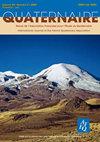Karst landscapes in South-Eastern Turkey: potential of cave speleothems to record the Last Glacial Maximum and Holocene climate
IF 0.7
4区 地球科学
Q4 GEOSCIENCES, MULTIDISCIPLINARY
引用次数: 0
Abstract
Field investigation in the eastern flanks of Taurus mountains in south-eastern Turkey, show a variety of karst landscapes, comprising polje, ponors, canyons, and multi-cave levels. The eastern Anatolian region is in an active tectonic margin traversed by both the Euphrates and Tigris headwaters. In the region, some of the Tigris river tributaries are diverted by underground karst drainage. Many cave-level systems and abandoned ponors, demonstrate that the karst dynamic is related to/or evolving with the surficial drainage. In this frame, the Birkleyn and Bozoba caves (Dicle district) have been investigated to evaluate their potential for geomorphological and paleoclimate studies. Indeed, both caves display preserved detrital sediments and speleothems, while their location in the eastern Taurus mountains make both caves suitable sites for regional paleoclimate reconstruction as reconstructed by the geochemical study and dating of speleothems. The first Uranium-Thorium ages of Bozoba-1 and Bozoba-2 show a start of growth at 22.4 ± 0.2 ka BP and 25.1 ± 0.5 ka BP respectively. Further dating of Bozoba-2 at 2.8 ± 0.2 ka BP and Birk-2 at 0.8 ± 0.2 ka BP shows rapid calcite growth during the late Holocene. As a result of these preliminary dates, we shall conduct geochronological and geochemical analyses on the sampled stalagmites, to reconstruct the climatic variations during the Last Glacial Maximum and late Holocene periods as recorded by the eastern Taurus range.土耳其东南部的喀斯特景观:记录末次盛冰期和全新世气候的洞穴洞穴主题的潜力
在土耳其东南部托罗斯山脉东侧的野外考察中,发现了多种多样的喀斯特地貌,包括波谷、波谷、峡谷和多洞层。东安纳托利亚地区处于一个活跃的构造边缘,幼发拉底河和底格里斯河的源头都穿过该边缘。在该地区,底格里斯河的一些支流被地下岩溶水系改道。许多洞穴级系统和废弃的ponors表明喀斯特动力与地表排水有关或随地表排水演变。在这个框架下,研究人员对Birkleyn和Bozoba洞穴(Dicle区)进行了调查,以评估它们在地貌学和古气候研究中的潜力。事实上,这两个洞穴都显示了保存完好的碎屑沉积物和洞穴化石,它们位于金牛座山脉东部,通过地球化学研究和洞穴化石测年重建了区域古气候。Bozoba-1和Bozoba-2的第一次铀钍年龄分别在22.4±0.2 ka BP和25.1±0.5 ka BP开始生长。Bozoba-2(2.8±0.2 ka BP)和Birk-2(0.8±0.2 ka BP)的进一步测年表明,方解石在全新世晚期快速生长。根据这些初步数据,我们将对石笋样品进行年代学和地球化学分析,以重建金牛座山脉东部记录的末次盛冰期和全新世晚期的气候变化。
本文章由计算机程序翻译,如有差异,请以英文原文为准。
求助全文
约1分钟内获得全文
求助全文
来源期刊

Quaternaire
地学-地球科学综合
CiteScore
1.70
自引率
0.00%
发文量
18
审稿时长
>12 weeks
期刊介绍:
La revue Quaternaire créée dès 1964 par l"AFEQ sous le nom de Bulletin de l"AFEQ est devenue Quaternaire en 1990. Ce journal scientifique paraît au rythme de quatre numéros par an. La revue publie des numéros d"auteurs (par ordre d"arrivée des manuscrits après acceptation) ou des numéros thématiques sur proposition ou invitation par le comité de rédaction. Les articles (en langue française, anglaise ou allemande) traitant de tous les aspects du Quaternaire sont acceptés. La revue est publiée avec le concours du Centre National de la Recherche Scientifique.
 求助内容:
求助内容: 应助结果提醒方式:
应助结果提醒方式:


